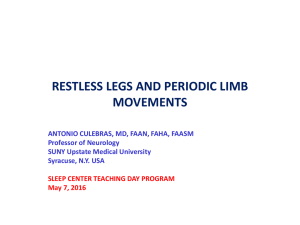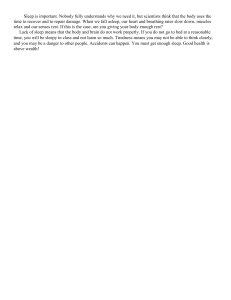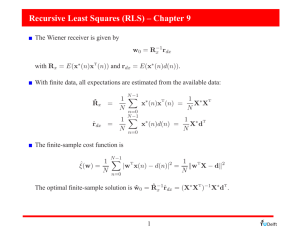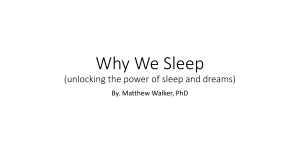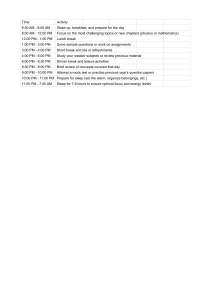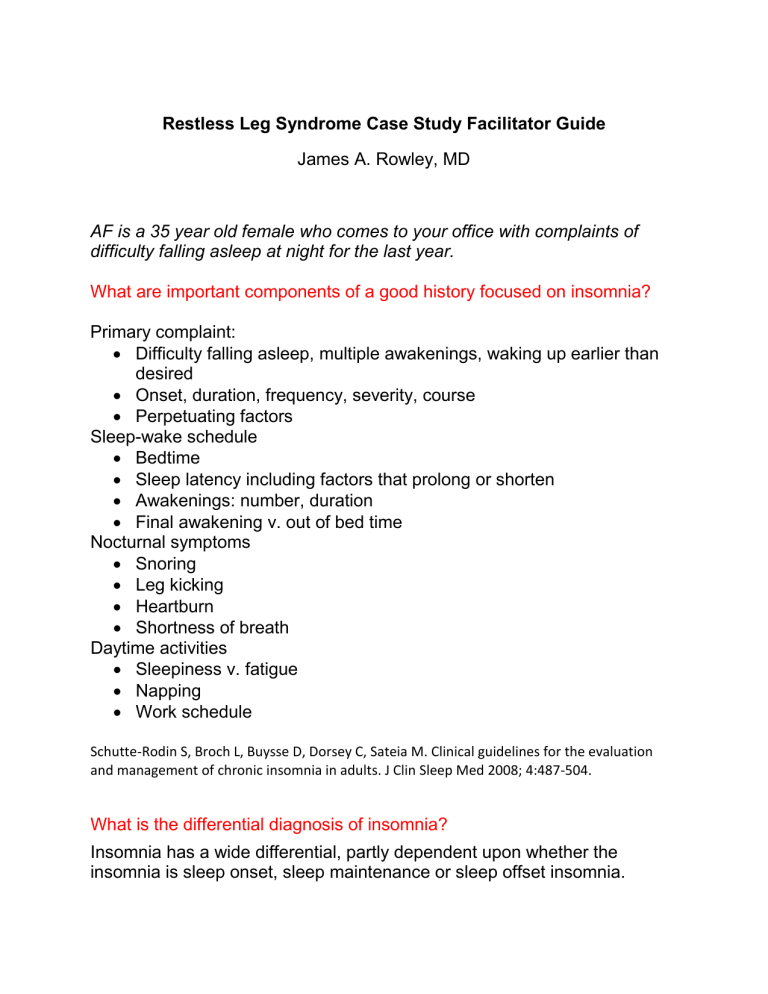
Restless Leg Syndrome Case Study Facilitator Guide James A. Rowley, MD AF is a 35 year old female who comes to your office with complaints of difficulty falling asleep at night for the last year. What are important components of a good history focused on insomnia? Primary complaint: • Difficulty falling asleep, multiple awakenings, waking up earlier than desired • Onset, duration, frequency, severity, course • Perpetuating factors Sleep-wake schedule • Bedtime • Sleep latency including factors that prolong or shorten • Awakenings: number, duration • Final awakening v. out of bed time Nocturnal symptoms • Snoring • Leg kicking • Heartburn • Shortness of breath Daytime activities • Sleepiness v. fatigue • Napping • Work schedule Schutte-Rodin S, Broch L, Buysse D, Dorsey C, Sateia M. Clinical guidelines for the evaluation and management of chronic insomnia in adults. J Clin Sleep Med 2008; 4:487-504. What is the differential diagnosis of insomnia? Insomnia has a wide differential, partly dependent upon whether the insomnia is sleep onset, sleep maintenance or sleep offset insomnia. For sleep onset insomnia, important considerations are: chronic primary insomnia, inadequate sleep hygiene, excessive use of stimulants (particularly caffeine or tobacco), obstructive sleep apnea, restless leg syndrome, sleep phase delay disorder, pain syndromes (fibromyalgia, osteoarthritis) For sleep maintenance insomnia, important considerations are: obstructive sleep apnea, GERD, asthma, periodic limb movement disorder, pain syndromes. For sleep offset insomnia: depression, sleep phase advance disorder. It is also important to remember that insomnia can be secondary to a wide variety of other medical and neurologic disorders including congestive heart failure, COPD, Parkinson’s disease, dementias and collagen vascular diseases. Many psychiatric disorders are also associated with insomnia including depression, bipolar disorder, anxiety disorder, schizophrenia. Schutte-Rodin S, Broch L, Buysse D, Dorsey C, Sateia M. Clinical guidelines for the evaluation and management of chronic insomnia in adults. J Clin Sleep Med 2008; 4:487-504. Upon further questioning, AF states: • Bedtime is at 11p and generally takes her 30-45 minutes to fall asleep • Wake time is 7a weekdays, 8a on weekends • When cannot fall asleep, generally stays in bed watching the clock • While trying to fall asleep, feels restless and is constantly moving her legs • Does not watch TV or read in bed • Only drinks juices or herbal tea after dinner • Does not smoke or consume alcohol • Is generally sleepy when gets into bed at night • Does not worry about her sleep during the day • Feels fatigued during the day What additional questions should be asked to confirm the diagnosis of restless leg syndrome? There are four key questions for RLS; if all 4 are positive, the patient has RLS. Do you have an urge to move, usually due to uncomfortable sensations (described as creeping, crawling, aching), primarily in the legs? Is the urge to move partially/totally relieved by movements (walking/stretching)? Are the symptoms worsening by relaxation (elevation of legs in recliner or bed) or improved if move legs? Is there day to day variability but generally worse in evening and early in the night? If not all four questions are positive, additional questions should be asked: • Is there a family history of RLS? o 50% of patients have a positive family history. o First degree relatives (risk 2-6 higher than general population o Earlier onset of symptoms • Is there leg kicking during the night? o 80% of patients with RLS have periodic limb movements, often noted by bed partner o If no bed partner, ask if sheets are messy in the morning International Classification of Sleep Disorders, 3rd Edition. American Academy of Sleep Medicine, 2014 Are there any questionnaires for RLS? The International Restless Leg Syndrome Study Group Rating Scale (IRLS) is a validated questionnaire for RLS symptoms and severity. It is a 10 question scale that measures both the frequency and severity of the key clinical characteristics of RLS as well as associated effects on mood and function. The IRLS has been shown to have good reliability and validity and correlates with clinical global impression scales. While frequently utilized in studies of RLS, particularly treatment trials, it is not clear if this scale is used extensively by clinical sleep centers. Walters AS, LeBrocq C, Dhar A, Hening W, Rosen R, Allen RP, Trenkwalder C; International Restless Legs Syndrome Study Group. Validation of the International Restless Legs Syndrome Study Group rating scale for restless legs syndrome. Sleep Med. 2003 Mar;4:121-32. Allen R, Oertel W, Walters R, Benes H, Schollmayer E, Grieger F, Moran K, Kohnen R. Relation of the International Restless Legs Syndrome Study Group rating scale with the Clinical Global Impression severity scale, the restless legs syndrome 6-item questionnaire, and the restless legs syndrome-quality of life questionnaire. Sleep Med 2013; 14:1375-1380. Upon further questioning, AF states that: • The restlessness in her legs often feels like something is crawling up them • The restlessness generally improves if she moves her legs around • She occasionally notices the creepy-crawly feeling when watching TV in her living room if lying on couch • Symptoms bother her at least 4 nights per week • Had similar symptoms about 5 years ago during her pregnancy • Her father and brother have similar symptoms Given the diagnosis of RLS: Which medications need to be checked for? Several studies have identified an increased prevalence of RLS in patients taking antidepressants. Antidepressants identified in these studies as having increased risk include citalopram, paroxetine, mirtazapine, amitriptyline and fluoxetine. While not all studies have found this association, it is accepted that physicians should ask patients with RLS about these medications and a trial of discontinuation may be considered. Other medications that may cause restless leg symptoms include medications that antagonize dopamine receptors such as metoclopramide, haloperidol, and olanzapine. There are also reports for over the counter antihistamines (such as diphenhydramine) worsening RLS symptoms, particularly in patients with end stage renal disease. Baughman K, Bourguet C, Ober S. Gender differences in the association between antidepressant use and restless legs syndrome. Mov Disord 2009;24:1054-9. Rottach KG, Schaner BM, Kirch MH, et al. Restless legs syndrome as side effect of second generation antidepressants. J Psychiatr Res 2008;43:70-5 Bliwise DL, Zhang RH, Kutner NG. Medications associated with restless leg syndrome: a case control study in the US Renal Data System (USRDS). Sleep Med 2014;15:1241-45 Hoque R, Chesson AL. Pharmacologically induced/exacerbated restless legs syndrome, periodic limb movements of sleep, and REM behavior disorder/REM sleep without atonia: literature review, qualitative scoring, and comparative analysis. J Clin Sleep Med. 2010;6:79-83. What diagnostic testing is indicated? Restless leg syndrome is a clinical diagnosis that is made when the patient answers in the affirmative regarding the key clinical characteristics of the disease. Thus, no diagnostic testing is indicated or needed to make the diagnosis. However, there is an association between iron deficiency, as measured by the ferritin level, and RLS. Thus, it is recommended that a ferritin level be checked in all patients; studies have suggested that ferritin levels <50-75 mcg/L are associated with increased RLS severity. Note that this cutoff level is generally much higher than that associated with iron deficiency (generally <20 mcg/L). Silber MH, Becker PM, Early C, Garcia-Borreguero D, Ondo WB. Willis-Ekbom Disease Foundation revised consensus statement on the management of restless leg syndrome. Mayo Clin Proc 2013; 88:977-986. What treatment options are available for RLS and what would you recommend for this patient? Treatment for RLS is primarily pharmacologic as there is insufficient evidence for non-pharmacologic therapies. The American Academy of Sleep Medicine has published practice parameters for the treatment of RLS. In these parameters, medications are recommended at three different levels of evidence/support: standard (highest), guideline and option (lowest). There are three general classes of medications that can be used for RLS. Common medications and the level of recommendation are given in the table below. Class of Medication Medication Level of Recommendation Dopamine Agonists Narcotics Anticonvulsants Ropirinole Pramipexole Levodopa Rotigotine No specific drug listed in guidelines Gabapentin encarbil Gabapentin Pregabalin, Standard Standard Guideline Guideline Guideline Carbamezapine Option Guideline Option Option Generally, dopamine agonists are considered the first line of therapy. There is no data comparing ropirinole and pramipexole, so either makes a good first choice of therapy. Both need to be taken about one hour before bedtime to be effective, so they are good choices for patients with symptoms multiple nights per week. Levodopa has a shorter onset of action and can be taken just at bedtime; therefore, it can be a good choice for patients with more intermittent symptoms. The major problem with all dopamine agents (though more so with levodopa) is that patients can develop augmentation, in which symptoms will occur earlier in the evening and often more severely. Narcotics are generally used for severe, nightly symptoms. No specific drug was named in AASM guidelines. Some of the narcotics that have been studied include oxycodone, propoxyphene, codeine, tramadol and methadone. Given the association between low ferritin and RLS, it would appear reasonable that iron supplementation would resolve RLS in patients with low ferritin. However, the evidence for iron supplementation is contradictory, with some support for supplementation only in those patients with a low ferritin. Therefore, it is reasonable to try iron supplementation in patients with a low ferritin. Guidelines suggest continuing iron supplementation is greater than 75 mcg/L. For the case under discussion, since the patient is having symptoms 4 nights per week, it would be reasonable to do the following: 1. Review medication list to make sure not on an antidepressant 2. Check ferritin and consider iron supplementation if low 3. Start either ropirinole or pramipexole nightly Aurora NR, MD, Kristo DA, Bista SR, Rowley JA, Zak RS, Casey KR, Lamm CI, Tracy SL, Rosenberg RS. The treatment of restless legs syndrome and periodic limb movement disorder in adults— an update for 2012: practice parameters with an evidence-based systematic review and metaanalysis. Sleep 2012; 35:1036-1062. Silber MH, Becker PM, Early C, Garcia-Borreguero D, Ondo WB. Willis-Ekbom Disease Foundation revised consensus statement on the management of restless leg syndrome. Mayo Clin Proc 2013; 88:977-986. Is RLS associated with other medical disorders and long term health outcomes? RLS is a common sleep disorder, effecting ~3% of men and 5-7% of women ages 50-70 years. Frequency in both genders increases across the age spectrum. Thus, RLS may be present in patients with other medical conditions. However, there are several other medical conditions that are clearly associated with RLS. These include: 1. Iron-deficiency anemia: iron is required for the synthesis of dopamine 2. Pregnancy: likely related to changes in iron metabolism during pregnancy; there is an increased risk of RLS in pregnancy; in addition, for women with RLS during pregnancy, there is an increased risk of developing chronic RLS later in life. 3. End-stage renal disease: 2-5x higher prevalence; likely related to changes in iron metabolism in ESRD 4. Parkinson’s disease: both RLS and Parkinson’s are diseases associated with dopamine deficiency 5. Multiple sclerosis: studies have shown increased prevalence compared to general population There is evidence that suggests that RLS is associated with hypertension and cardiovascular disease, but the strength of the association varies between different studies; while the majority show an association, there are several that show no association. Differences in results may relate to type of epidemiologic study (prospective cohort v. case-control) and the population being studied. There is also conflicting data as to whether RLS is associated with increased mortality. International Classification of Sleep Disorders, 3rd Edition. American Academy of Sleep Medicine, 2014 Leschziner G, Gringras P. Restless leg syndrome. BMJ 2012; 344:e3056 Yeh P, Walters AS, Tsuang JW. Restless legs syndrome: a comprehensive overview on its epidemiology, risk factors, and treatment. Sleep & Breath 2012;16:987-1007. Ferini-Strambi L, Walters AS, Sica D. The relationship among restless legs syndrome (WillisEkbom Disease), hypertension, cardiovascular disease, and cerebrovascular disease. J Neurol 2014; 261:1051-1068. You prescribe AF pramipexole 0.5 mg one hour before bedtime. AF returns after 2 months with marked improvement in: • Symptoms of restlessness: now only bother her about 1x/month • Sleep latency most nights ~10 minutes What is the relationship between RLS and periodic limb movements during wakefulness (Figure 1) and sleep (Figure 2) as observed on a sleep study? Periodic limb movements during sleep (PLMS, Figure 1) are seen in ~7080% of sleep studies on single night testing but >90% if tested multiple nights. However, the presence of PLMS is not needed for the diagnosis of RLS and the presence of PLMs is not sufficient to make the diagnosis of RLS. However, PLMS are a supportive feature for RLS if the patient does not answer ‘yes’ to the four key clinical characteristics. PLMS tend to be more frequent during the early part of the night and vary in frequency night to night. Periodic leg movements during wakefulness (PLMW, Figure 2) have been shown in one study to be a sensitive (87%) and specific (80%) marker of RLS; other parameters, such as the periodic limb movement index during sleep, where not discriminatory. Michaud M, Paquet J, Lavigne G, Desautels A, Montplaisir J. Sleep laboratory diagnosis of restless leg syndrome. Eur Neurol 2002; 48:108-113.

